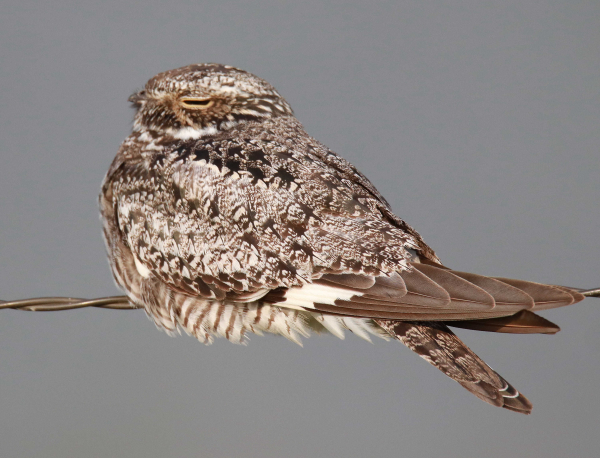
The first of 2 photographs taken of a beautifully colored Common Nighthawk perched on a barbed wire. The first photo was taken with the nighthawk in this relaxed position with its plumage fluffed a bit with a moody water color providing the background.

A second visit to the nighthawk’s perch revealed it in a very horizontal position with its plumage held close to its body. For this photo I positioned myself with the prairie blurred out of focus. Note the small beak and large, partly closed eye of this nocturnal aerial hunter of insects.
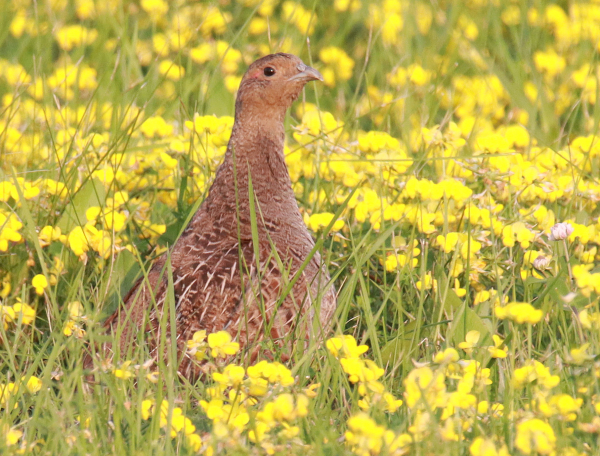
Three groups of Gray Partridges were active in the area of southwest Fargo where I also observed an Osprey.
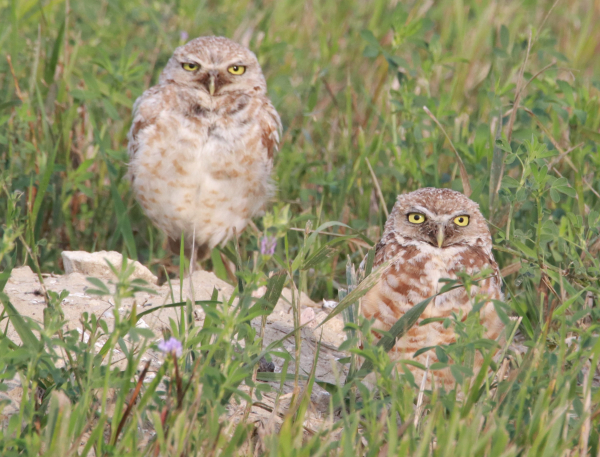
Surprise! Not only did Paul refind the sun-bleached Burrowing Owl sighted last week, it was with another owl – a potential mate, at a potential nesting burrow. However, the owls have not been seen since the pair was located and photographed.
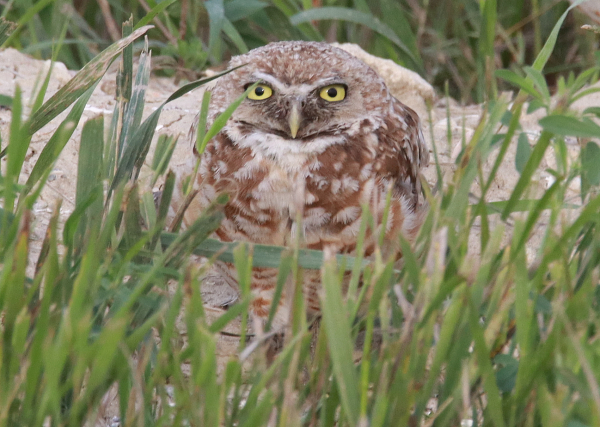
A closer look at the new Burrowing Owl standing next to the burrow entrance, presumably a female.
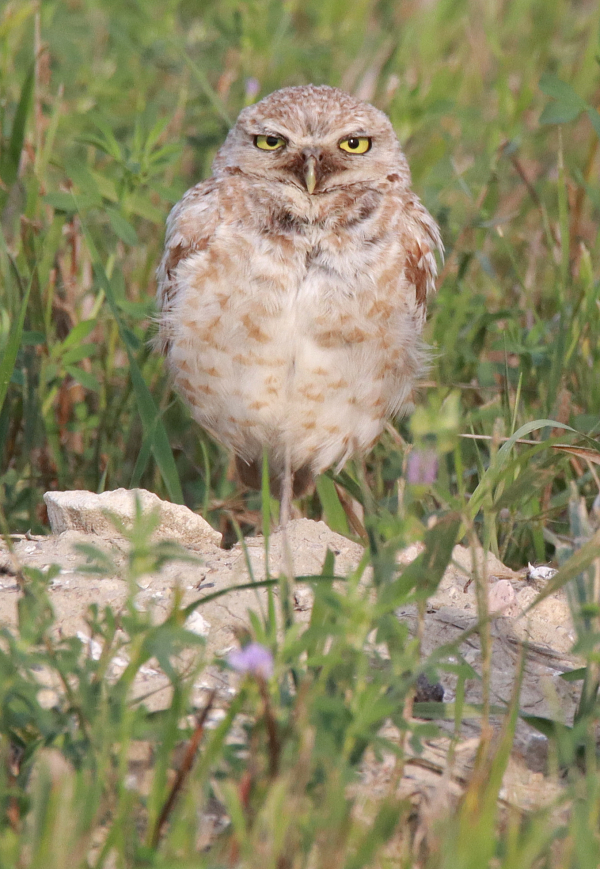
The original Burrowing Owl with the sun-bleached plumage provided a second observation, but new questions arise with this male in the company of a female at a burrow opening. If only owls could talk; but the real question at this time is will the owls provide another observation to add to this Burrowing Owl saga?
|
Remember my sighting of a Burrowing Owl last week that fairly surprised me for being so far east of the species’ western range? Well, of course I wanted to check back to see if I could find it again. My original sighting was the evening of Saturday, July 27, so the next evening I returned and saw no sign of an owl, even after checking a couple miles south, north, and west. Frankly, I didn’t expect to see it again, but I wanted to check for it anyway. Tuesday evening I returned to look for the owl again, but again, without luck. These kinds of sightings are usually a one-time surprise, and I figured the owl was likely on the move after the nesting season and it probably continued its sojourn soon after I observed it.
I drove a couple miles north, found and photographed a Swainson’s Hawk, and returned toward the area of the original owl sighting. As I approached the location, I saw a tan-colored animal catch the light of the sun as it stood upright on the ground near the large hay bale where I observed the Burrowing Owl originally. A ground squirrel came to mind from that distance, but as I turned onto the shoulder of the road, I realized it was THE Burrowing Owl! But wait, there were 2 small owls!
There was the original Burrowing Owl with the highly sun-bleached plumage, plus a slightly smaller Burrowing Owl with normally colored plumage that was bending low behind a thin veil of grasses. Better yet, they were standing on opposite edges of an open area of ground covered with the dirt excavated from a burrow, likely dug out by a ground squirrel – this was a typical underground nesting site for Burrowing Owls! Are you kidding me?! Could this be a nesting pair with growing young underground? WoW, this was more than just a one-time sighting after all. Of course, I took a few photographs to document this exciting find as a possible nesting record. I certainly wouldn’t have imagined that would be the case when I found the small owl the previous Saturday evening.
Wednesday I was out of town, but I checked back on the Burrowing Owls Thursday evening, twice; but I found no sign of the owls – hmm. Did I overthink the observation again? A Friday evening drive by yielded the same negative results, so this time I decided to check the location where the pair of owls was present Tuesday; was there a burrow as imagined? Yes, definitely a burrow, and there were 2 recent Burrowing Owl pellets that showed a lot of vole hair, apparently their preferred food – oh, and a molted breast feather.
It’s not unusual for Burrowing Owls to rest below ground, or they could be on the hunt nearby, or simply resting out of sight. The study of owl behavior at a burrow that I am most familiar with showed the pair of Burrowing Owls were active 40 percent of the time during daylight periods and 60 percent at night. Even so, I have checked back every other day since without seeing the owls again, but I’ll keep monitoring the area. Burrowing Owl nesting observations can be like that.
At that point I turned my attention to the sexes of the apparent pair; Birds of the World showed a photo of a male and female, and described the differences: “In fresh plumage it is difficult to distinguish males from females, though males may average paler. In summer, however, males are usually distinctly paler due to sun bleaching and wear, because they spend all their time outside the burrow, whereas females spend more time in the burrow, and remain darker brown.” So the initial sun-bleached owl was a male, and the darker bird that stood next to the burrow entrance was the female.
Beyond the Burrow
During last Thursday’s owl check, I was actually on a broader birding drive to do an evening census of birds of prey along my Raptor Route, while checking out all the birds and wildlife I found along the way. My raptor count was fairly impressive with a total of 27 raptors observed, including 12 Swainson’s Hawks, 12 Red-tailed Hawks, 1 Ferruginous Hawk, 1 female Northern Harrier, and 1 male American Kestrel – more than I imagined.
When I visited my nieces and nephews in Fargo last Wednesday I checked for Gray Partridges in their neighborhood on the southwest edge of the city, and found a big surprise – an Osprey! It was perched on a tall metal powerline tower as it ate something. Ospreys are rarely seen in the Great Plains of North Dakota, so it joins the growing list of birds that appear to be on the move beyond their nesting ranges these days. I also observed 3 groups of Gray Partridges, including a pair and 2 family groups. There were still American Kestrels in the area too, with at least 2 on the hunt.
My home and office are in duck brood central, but now it’s hard to distinguish half of the broods from groups of molting adults at times. Melody’s Marsh just a half-mile to the south had a new brood of 6 Mallard ducklings last week and Bobby’s Bay has attracted a few broods from the larger marsh, including a couple Gadwall broods, a Northern Pintail brood, a couple Blue-winged Teal broods, and a Mallard brood. Each summer about mid-July male Wood Ducks begin to appear in the area to molt, and now there are a couple groups numbering a half-dozen.
More wading birds are filtering into the area too, including Great Egrets and an occasional Great Blue Heron and Snowy Egret. I also observed the first flock of about 40 Cattle Egrets along the Raptor Route that were scattered among a small herd of resting angus cattle. White Pelicans and Double-crested Cormorants are common in the area, and now molting Franklin’s Gulls, Ring-billed Gulls, and Black Terns are lively, along with an occasional Common Tern.
As for shorebirds, there were about 60 Long-billed Dowitchers at Bobby’s Bay for a week or so, but as of Saturday they have been absent. Charo Marsh had a nice variety of shorebirds Sunday evening, but only a few individuals of each species, including Semipalmated Plovers, Stilt Sandpipers, Long-billed Dowitchers, Lesser Yellowlegs, Pectoral Sandpipers, Least Sandpipers, and a few Killdeer. During the week I observed 2 broods Ring-necked Pheasants with attendant hens, and throughout the summer there have been occasional Sharp-tailed Grouse – pairs or single birds.
Hummingbirds & Orioles – Last Wednesday seemed to be the day the grape jelly birds left – the Orchard Orioles and American Robins that nested in the area seemed to leave all at once. That big loss has pretty much limited the activity at my feeding station to my nectar feeder, where the week began with sporadic visits by a molting male Ruby-throated Hummingbird. But by Friday the molting male became a regular nectar feeder, as did a female Saturday through Tuesday (yesterday), and it appears they are dialed in for a while. New sightings adjacent to the feeding station included an adult female Downy Woodpecker Thursday afternoon, an adult White-breasted Nuthatch Friday afternoon, and a Chipping Sparrow Monday afternoon.
A highlight to top off the week was a Common Nighthawk I encountered as it perched on a barbed wire, which seemed like something of a tightrope balancing act that I don’t think I’ve witnessed before. The nighthawks I usually encounter are perched on the ground or on the top of a low fencepost. I didn’t get too excited until I took a closer look at this nighthawk through my camera lens and appreciated the true beauty of this bird’s plumage, which was so pristine the bird must be a recent fledgling. While photographing shorebirds in that area, I revisited the young nighthawk a couple times, which revealed the young bird with its plumage “fluffed” as it perched upright the first time, but positioned almost horizontally with its plumage tucked close to its body the second time – all while balancing in the same spot on wire.
I appreciate the nighthawk photos so much that its story is a fitting end to this report, although I feature the photos of it first, at the top of this article. In the meantime, I hope you find an engaging bird, an interesting bird, a pair of rare birds, even a new bird, soon – it could happen; it all happened to me last week! Good Luck.
Article and Photos by Paul Konrad
Share your bird sightings and photographs at editorstbw2@gmail.com